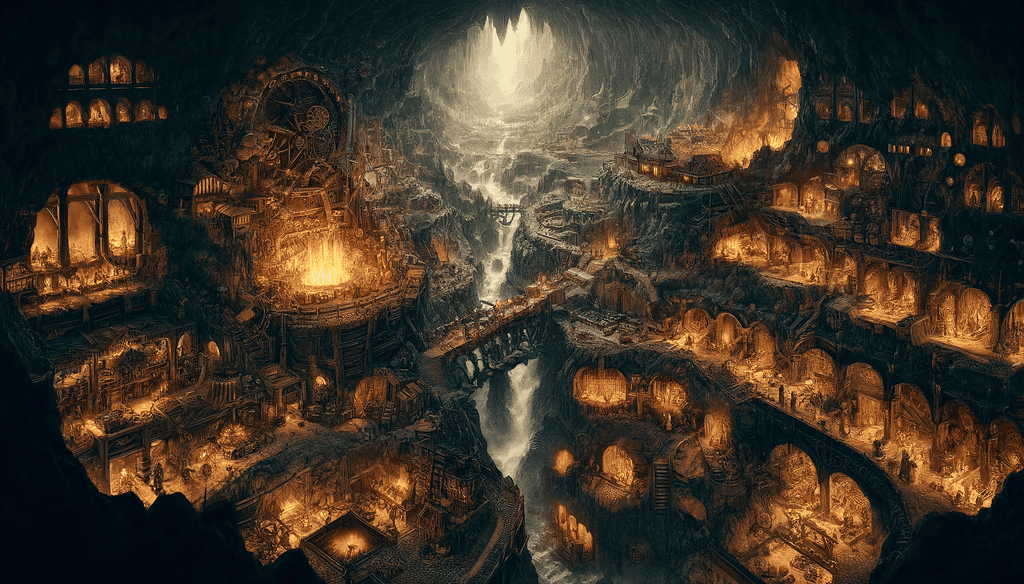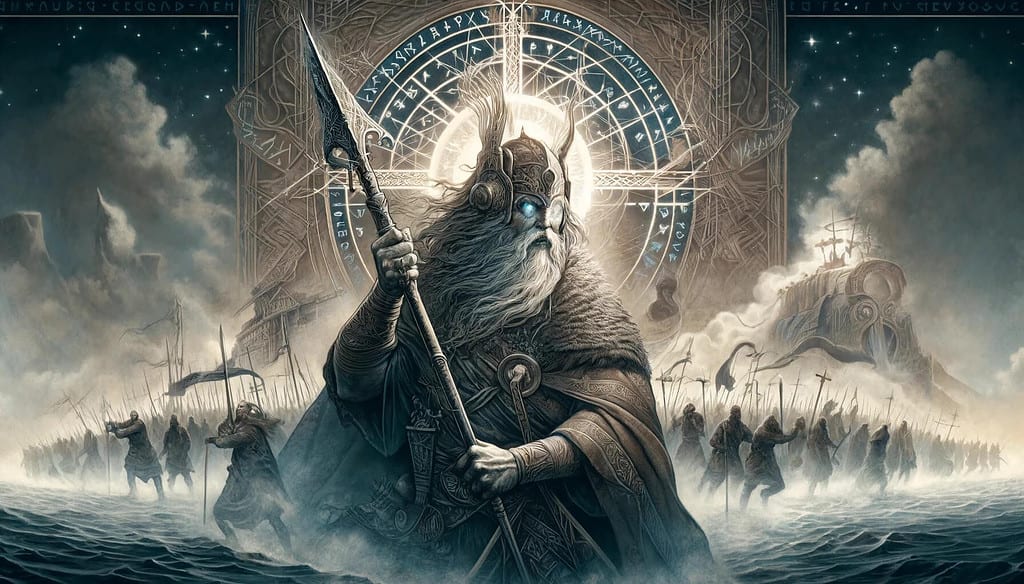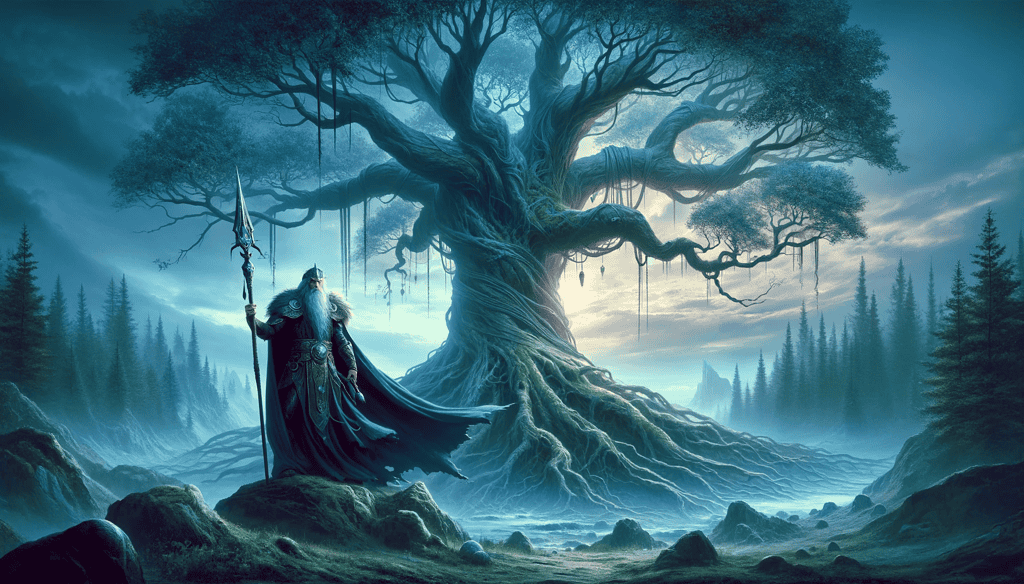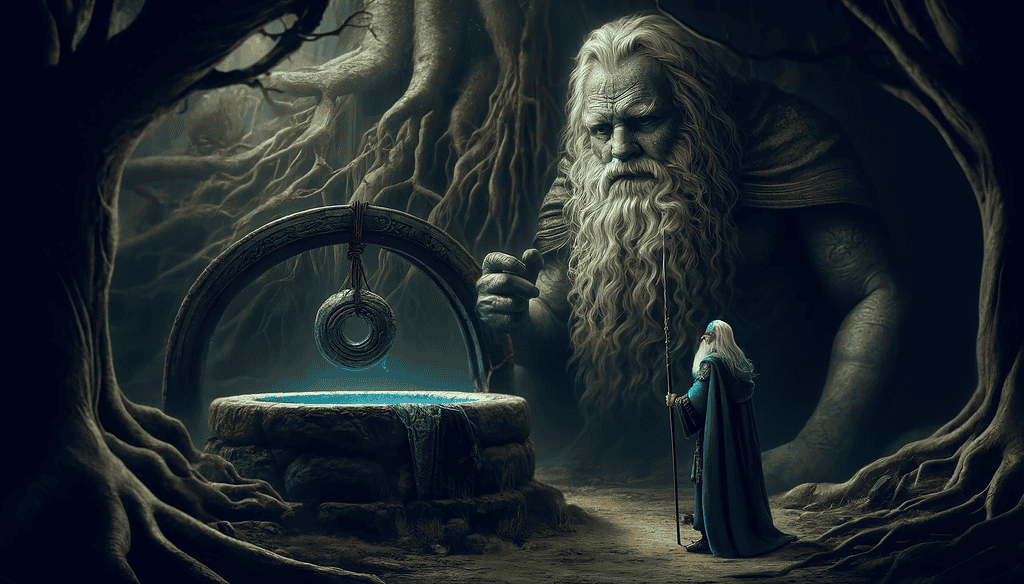No products in the cart.
May 27, 2024 1:57 pm
May 27, 2024 1:57 pm
Gungnir, the legendary spear of Odin, holds a significant place in Norse mythology. This magical weapon, known for its unfailing accuracy, symbolizes Odin’s divine power and authority. Forged by the skilled dwarves known as the Sons of Ivaldi, Gungnir was a gift to Odin, enhancing his status as the Allfather.
Gungnir is more than just a weapon; it represents the wisdom and might of Odin. The spear’s unerring nature and the runes carved into its tip make it a powerful symbol in Viking lore.
Stories of Gungnir’s creation and its role in various myths offer a deeper understanding of its importance in Norse culture. As we delve into the origins and powers of this mighty spear, we uncover the rich tapestry of myths and legends that surround Gungnir.

Gungnir was gifted to Odin by the dwarves known as the Sons of Ivaldi. These dwarves were renowned for their extraordinary craftsmanship and magical abilities.
They were capable of creating items imbued with incredible powers, and Gungnir was no exception. This spear, destined to be one of the most powerful weapons in Norse mythology, was a creation that showcased their unmatched skill.
The Sons of Ivaldi crafted Gungnir at the behest of Loki, the trickster god. Loki had orchestrated a series of events that led to the creation of several magical items, including Gungnir.
He sought to appease the gods after causing mischief that put him in a precarious position. Loki’s cunning plan involved commissioning the dwarves to craft these wondrous gifts, which he then presented to the gods as tokens of reconciliation.
The creation of Gungnir was driven by a combination of Loki’s scheming and the dwarves’ unparalleled craftsmanship. Loki, always the trickster, had cut off the hair of Sif, Thor’s wife. To avoid Thor’s wrath, he promised to replace her hair with something even more magnificent. To fulfill this promise and escape his predicament, Loki turned to the Sons of Ivaldi.
Loki persuaded the dwarves to create a series of magnificent gifts, including Sif’s golden hair, the ship Skidbladnir, and Gungnir, the spear destined for Odin.
The dwarves, motivated by the challenge and their desire to showcase their skills, crafted these items with great care and magical prowess. Gungnir, with its ability to always hit its target and never miss, was a gift worthy of Odin, the chief of the gods.
The spear Gungnir not only served as a powerful weapon but also as a symbol of Odin’s authority and divine power. The runes carved into its tip, which granted it its magical properties, represented the deep connection between the gods and the mystical forces of the Norse cosmos.
Through Loki’s mischief and the dwarves’ craftsmanship, Gungnir became an iconic symbol in Norse mythology, representing the strength and wisdom of Odin.

The runes etched into Odin’s spear, Gungnir, are not specifically identified in the primary sources of Norse mythology. While the Sigrdrífumál, a poem from the Poetic Edda, mentions that runes were carved on the tip of Gungnir, it does not detail which runes were used.
This lack of specificity extends across the various sources that discuss Gungnir and its attributes, including the Prose Edda.
Despite the significant role of runes in Norse mythology and their application for magical purposes, the exact runes on Gungnir remain unspecified in the surviving literature and mythological accounts .
This mystery surrounding the runes adds to the intrigue of Gungnir, making it not just a powerful weapon but also an enigmatic artifact within Norse mythology.
The unspecified runes contribute to the spear’s legendary status, inviting speculation and interpretation about the nature of its magic and the intentions behind its creation.
As a result, Gungnir continues to captivate the imagination of those interested in the rich tapestry of Viking lore and Norse paganism.
In various myths, Odin wields Gungnir as a symbol of his authority and divine power. One notable instance is during the Aesir-Vanir War, where Odin uses Gungnir to initiate the conflict by hurling it over the heads of the enemy, marking the start of the battle. This act signifies the spear’s role in war and the invocation of Odin’s will.
Odin is often depicted with Gungnir in scenes of judgment and sacrifice.
For instance, during the ritual of self-sacrifice, Odin stabbed himself with Gungnir and hung on Yggdrasil for nine nights to gain the knowledge of runes. This sacrifice highlights the spear’s connection to wisdom and the profound sacrifices Odin makes for knowledge and power.
Gungnir also features in the Prose Edda, where Odin uses it to influence battles and decisions among gods and men. The spear’s presence in these myths underscores its importance not just as a weapon, but as a tool of Odin’s influence and control over fate.
Gungnir is renowned for its magical properties, chief among them being its unerring accuracy. The spear is said to never miss its target, a trait that underscores Odin’s formidable power and precision. This ability is not merely a testament to craftsmanship but is also imbued with the magical essence of the runes etched onto its tip.
The runes carved into Gungnir, while not specified in primary sources, are believed to enhance its lethality and accuracy.
These runes symbolize the deep connection between Odin and the mystical forces of the Norse cosmos. Gungnir’s unbreakable nature adds another layer to its might, making it an indestructible weapon in the hands of the Allfather.
In addition to its physical prowess, Gungnir symbolizes authority and the divine right to rule. It is a representation of Odin’s role as the chief of the gods and his ability to enforce his will across the Nine Realms.
The spear’s presence in rituals and sacrifices further cements its status as a conduit of Odin’s power and a symbol of his unyielding might.
Through its various attributes, Gungnir stands as one of the most powerful and revered weapons in Norse mythology. Its unerring aim, unbreakable nature, and the mysterious runes that adorn it all contribute to its legendary status.
As both a weapon and a symbol, Gungnir embodies the essence of Odin’s divine authority and the mystical heritage of the Norse gods.

Gungnir features prominently in several Norse mythology stories, emphasizing its significance and the power it bestows upon Odin. One of the earliest mentions of Gungnir is in the Prose Edda, where it is described as a spear that never misses its target. This unerring accuracy is a recurring theme in myths involving Gungnir.
In the tale of the Aesir-Vanir War, Odin uses Gungnir to initiate the conflict by hurling it over the heads of the Vanir, signifying the beginning of the battle. This act not only marks the start of the war but also underscores Gungnir’s role as a harbinger of Odin’s will.
Another notable story is Odin’s self-sacrifice on Yggdrasil. Here, Odin pierces himself with Gungnir and hangs on the World Tree for nine nights to gain the knowledge of runes.
This act of sacrifice highlights Gungnir’s connection to wisdom and the profound lengths Odin goes to acquire power and knowledge.
Gungnir’s presence in various myths showcases its importance not just as a weapon but as a symbol of divine authority and wisdom. Its role in these stories reinforces the spear’s status as one of the most powerful artifacts in Norse mythology.
Gungnir and Thor’s hammer, Mjolnir, are two of the most iconic weapons in Norse mythology, each with its unique attributes and symbolic meanings. Gungnir, as Odin’s spear, symbolizes unerring accuracy, divine authority, and wisdom.
It is a weapon that never misses its target and is imbued with magical properties through the runes carved into its tip.
Mjolnir, on the other hand, represents Thor’s strength and protection. The hammer is known for its incredible power and its ability to return to Thor’s hand after being thrown.
Mjolnir is often used by Thor to protect Asgard and Midgard from giants and other threats, making it a symbol of defense and warrior might.
While Gungnir is associated with wisdom and authority, Mjolnir is more closely tied to physical strength and protection. Both weapons are forged by dwarves and possess magical properties, yet they serve different purposes and embody different aspects of Norse mythology.
In comparing Gungnir and Mjolnir, we see a reflection of the roles of Odin and Thor. Odin, as the chief of the gods, wields Gungnir to assert his divine will and wisdom. Thor, as the protector of Asgard, wields Mjolnir to defend the realms with his immense strength.
Together, these weapons and their wielders represent the balance of wisdom and strength that is central to Norse mythological narratives.

| Weapon | Wielder | Key Attributes | Origin | Symbolic Meaning |
|---|---|---|---|---|
| Gungnir | Odin | Unerring accuracy, runes etched on tip | Crafted by the Sons of Ivaldi, gifted by Loki | Divine authority, wisdom, power |
| Mjölnir | Thor | Returns to Thor’s hand, immense strength | Forged by dwarves Sindri and Brokkr | Protection, strength, warrior might |
| Skíðblaðnir | Freyr | Always favorable wind, can be folded up | Crafted by the Sons of Ivaldi | Prosperity, travel, magic |
| Draupnir | Odin | Creates eight new rings every nine nights | Forged by the dwarves Sindri and Brokkr | Abundance, wealth, fertility |
| Gram | Sigurd | Sharpness, used to slay the dragon Fafnir | Forged by the dwarf Regin | Heroism, victory, fate |
Gungnir, the spear of Odin, holds deep symbolic meaning in Norse culture. As a weapon that never misses its target, Gungnir represents precision and infallibility. This unerring accuracy is a reflection of Odin’s wisdom and foresight, showcasing his role as the chief of the gods who possesses unparalleled knowledge and strategic acumen.
The spear also symbolizes divine authority. Odin’s use of Gungnir to initiate battles, such as the Aesir-Vanir War, underscores his position as the arbiter of conflict and peace. Gungnir’s presence in these critical moments highlights its role as a tool of judgment and a symbol of Odin’s sovereign power.
Moreover, Gungnir is closely associated with the mystical aspects of Norse mythology. The runes carved into its tip, though unspecified in primary sources, indicate its connection to the magical and the sacred.
These runes are a testament to the deep interplay between magic and authority in Norse beliefs, with Gungnir embodying the divine right to rule and the mystical knowledge that underpins it.
Gungnir’s legacy extends far beyond its mythological origins. In modern interpretations of Norse mythology, Gungnir continues to be a potent symbol of Odin’s power and the rich tapestry of Viking lore. It is frequently depicted in literature, art, and popular culture, often as a symbol of ultimate authority and wisdom.
The spear’s unerring nature and its connection to runes have made it a subject of fascination for those interested in Norse paganism and magic.
Gungnir is not just seen as a weapon but as a representation of the intricate relationships between the gods, their tools, and the cosmos. This perspective invites a deeper appreciation of Norse mythology’s complexity and the symbolic layers within its stories.
In contemporary pagan practices, Gungnir is often invoked as a symbol of divine insight and strength. Its role in rituals and artistic representations reflects its enduring significance. As a cultural artifact, Gungnir bridges the ancient and the modern, maintaining its relevance through its powerful symbolism and the stories that continue to be told about it.
The legacy of Gungnir also influences modern Viking and Norse-themed jewelry and crafts. Items inspired by Gungnir are popular among enthusiasts of Norse mythology, serving as a reminder of the spear’s legendary status and its representation of Odin’s enduring influence.
Through these cultural expressions, Gungnir remains a vivid and dynamic symbol, connecting the past to the present and inspiring future explorations of Norse heritage.

Gungnir, the spear of Odin, stands as a powerful symbol of divine authority and unerring precision in Norse mythology. Crafted by the Sons of Ivaldi and gifted through Loki’s cunning, Gungnir’s origins are as intriguing as its mystical properties.
This legendary weapon never misses its target, embodying Odin’s wisdom and strategic prowess.
The runes etched into Gungnir, though unspecified in ancient texts, add a layer of mystery and magic, reflecting the deep connections between the gods and the mystical forces they wield.
Gungnir’s presence in various myths, such as the Aesir-Vanir War and Odin’s self-sacrifice, highlights its multifaceted role as a symbol of judgment, wisdom, and power.
Exploring Gungnir’s significance offers a window into the rich tapestry of Norse mythology and the values it imparts.
For those interested in Norse paganism and Viking lore, Gungnir serves as a reminder of the profound connections between myth, magic, and the divine.
By delving into the stories and symbols surrounding Gungnir, one can gain a deeper appreciation for the intricate and captivating world of Norse myths and their lasting impact on modern culture.